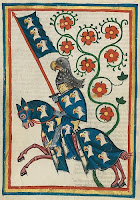The death of a wealthy duke leaves his very young son and daughter orphaned and destitute. The two have an incestuous union that produces a child, Gregorius, who is born when his parents are still only about eleven years old. A wise old man sends the father to Jerusalem on pilgrimage to repent of his sins. The father dies along the way. The same man tells the mother to put the child in a box and put the box out to sea so God can take care of him. The child is placed in a box with 20 pieces of gold and a tablet explaining his birth.
The box is found by two fishermen who are working on behalf of an abbey. The present the box to the abbot, who tells one of the fisherman to raise the boy as his own. When Gregorius is six, he begins his education under the abbot. He grows into a smart and handsome young man, which makes clear to those around him that he could not be the son of a mere fisherman. Realizing his family is not his own, he talks to the abbot, who gives him the tablet that explains his origin. In order to repent of his parents' sin, he becomes a knight to perform chivalric deeds.
Coming upon a besieged city, he frees it and wins the hand of its mistress. They marry, and he settles down in the city. A maid notices that, there is a room which the knight frequents, after which he always emerges with eyes red from crying. She leads Gregorius' wife there, and they find the tablet that explains his origin. The wife recognizes the tablet, because (in an Oedipal twist), she is the mother who bore him! She realizes that she is his mother and wife and aunt. When he discovers the truth, Gregorius tells his wife-mother to give away all her goods and live a life of poverty as penance. Gregorius has himself chained to a rock in the middle of a lake, and has the keys to his chains thrown into the water by a fisherman. The fisherman says that, if the key is ever found, it will be proof that Gregorius is a holy man whose penance has been accepted by god.
Well! Seventeen years later, two priests have a vision from God that the next pope will be found on a rock in Aquitania, repenting of his sins. The two set off to look for this man, and come upon the fisherman who chained him and threw the key. The fisherman should have simply offered them a meal, but instead he sells them a fish. When the fisherman cuts the fish open to clean it, he finds a key inside. He is horrified that he has chained a holy man to a rock, and also that after seventeen years the man is dead.
He ferries the two clergymen to the rock where they find an emaciated but still-living Gregorius. He unlocks the chain, and Gregorius goes off with the clergymen and becomes pope. As pope, he one day recognizes a poor and penitent woman as his mother, although she does not recognize him. He tells her who he is, and that their penance was sufficient to be forgiven by God.
A real rollercoaster of a story for the 12th century! But was this inspired by a legend of a pope who was the product of incest? Unknown, but incest does haunt the record of a pope who is also reputed to have been born of a concubine. Tomorrow let's look at the disturbing reign of Pope John XII.



